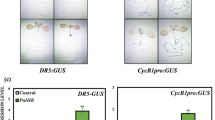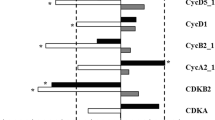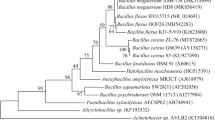Abstract
Determination of the optimal inoculation method and concentration to use for plant-bacteria interaction studies is important in many cases, such as the phytoremediation of heavy metals and other toxic compounds in contaminated areas. The aim of this study was to compare different concentrations and times of inoculation of Pseudomonas putida with various growth stages of Arabidopsis thaliana in 14-d in vitro cultures. A significant beneficial impact of the bacterium was detected in the shoot length and root weight of seedlings. The highest shoot length and root fresh and dry weights were detected in 14-d and 2 × 103 cfu mL−1 inoculated samples. In addition, the increase in root weight could be visualized with crystal violet staining, as relatively more root hair and lateral root formation occurred in seedlings inoculated with moderate concentrations of bacteria, possibly due to the ability of P. putida to produce indole-acetic acid. Moreover, the highest photosynthetic pigment accumulation was obtained with the highest bacterial inoculum (2 × 106 cfu mL−1), which was tested in 0- or 3-d-old seedlings. Rhizospheric bacterial colonization was also visualized with GFP-labeled bacteria by confocal microscopy. These results showed that biotization of A. thaliana with P. putida KT2440 did not cause severe oxidative stress in seedlings, because H2O2 accumulation levels together with CAT and POX activities were not significantly induced. Therefore, this strain could be used for several applications based on plant-bacteria interactions.







Similar content being viewed by others
References
Akkaya Ö, Pérez-Pantoja DR, Calles B, Nikel PI, de Lorenzo V (2018a) The metabolic redox regime of Pseudomonas putida tunes its evolvability towards novel xenobiotic substrates. MBio 9:e1512–e1518
Akkaya Ö, Batool M, Gül Şeker M (2018b). Usage of model plants to harness plant-bacterial endophyte interactions: a case study of Arabidopsis thaliana. 2nd international congress on advances in bioscience and biotechnology (ICABB), Podgorica, Montenegro
Backer R, Rokem JS, Ilangumaran G, Lamont J, Praslickova D, Ricci E, Subramanian S, Smith DL (2018) Plant growth-promoting rhizobacteria: context, mechanisms of action, and roadmap to commercialization of biostimulants for sustainable agriculture. Front Plant Sci 9:1473
Beauchamp C, Fridovich I (1971) Superoxide dismutase: improved assays and an assay applicable to acrylamide gels. Anal Biochem 1(44):276–287
Bradford MM (1976) A rapid and sensitive method for the quantification of microgram quantities of protein utilizing the principal of protein-dye binding. Anal Biochem 72:248–254
Caro A, Puntarulo S (1996) Effect of in vivo iron supplementation on oxygen radical production by soybean roots. Biochim Biophys Acta 1291:245–251
Chance B, Maehly AC (1955) Assay of catalases and peroxidases. Meth Enzymol 2:764–775
Droog F (1997) Plant glutathione S-transferases, a tale of theta and tau. J Plant Growth Regul 16:95–107
Elstner EF (1991) Oxygen radicals-biochemical basis for their efficacy. Wien Klin Wochenschr 69:949–956
Espinosa-Urgel M, Ramos JL (2004) Cell density-dependent gene contributes to efficient seed colonization by Pseudomonas putida KT2440. Appl Environ Microbiol 70:5190–5198
Espinosa-Urgel M, Salido A, Ramos JL (2000) Genetic analysis of functions involved in adhesion of Pseudomonas putida to seeds. J Bacteriol 182:2363–2369
Espinosa-Urgel M, Kolter R, Ramos JL (2002) Root colonization by Pseudomonas putida: love at first sight. Microbiol 148:341–343
Gaspar T (1998) Plants can get cancer. Plant Physiol Biochem 36:203–204
Gordon SA, Weber RP (1951) Colorimetric estimation of indoleacetic acid. Plant Physiol 26:192
Koornneef M, Meinke D (2010) The development of Arabidopsis as a model plant. Plant J 61:909–921
Li Y, Horsman M, Wang B, Wu N, Lan CQ (2008) Effects of nitrogen sources on cell growth and lipid accumulation of green alga Neochloris oleoabundans. Appl Microbiol Biotechnol 81:629–636
Lichtenthaler HK, Buschmann C (2001) Chlorophylls and carotenoids: measurement and characterization by UV-VIS spectroscopy. Curr Prot Food Anal Chem 1:F4–F3
Loper JE, Schroth MN (1986) Influence of bacterial sources of indole-3-acetic acid on root elongation of sugar beet. Phytopath 76:386–389
Matilla MA, Ramos JL, Bakker PAHM, Doornbos R, Badri DV, Vivanco JM, Ramos-González MI (2010) Pseudomonas putida KT2440 causes induced systemic resistance and changes in Arabidopsis root exudation. Environ Microbiol Rep 2:381–388
McKersie BD, Leshem YY (1994) Stress and stress coping in cultivated plants. Kluwer Academic Publishers, Dordrecht
Molina L, Ramos C, Duque E, Ronchel MC, García JM, Wyke L, Ramos JL (2000) Survival of Pseudomonas putida KT2440 in soil and in the rhizosphere of plants under greenhouse and environmental conditions. Soil Biol Biochem 32:315–321
Monti MR, Smania AM, Fabro G, Alvarez ME, Argarana CE (2005) Engineering Pseudomonas fluorescens for biodegradation of 2,4-dinitrotoluene. Appl Environ Microbiol:8864–8872
Murashige T, Skoog F (1962) A revised medium for rapid growth and bio assays with tobacco tissue cultures. Physiol Plant 15:473–497
Nikel PI, de Lorenzo V (2013) Implantation of unmarked regulatory and metabolic modules in Gram-negative bacteria with specialised mini-transposon delivery vectors. J Biotechnol 163:143–154
Nowak J (1998) Benefits of in vitro “biotization” of plant tissue cultures with microbial inoculants. In Vitro Cell Dev Biol Plant 34:122–130
Patra J, Panda KK, Panda BB (1997) Differential induction of adaptive responses by paraquat and hydrogen peroxide against the genotoxicity of methyl mercuric chloride, maleic hydrazide and ethyl methyl sulphonate in plant cells in vivo. Mut Res 393:215–222
Patten CL, Glick BR (2002) Role of Pseudomonas putida indoleacetic acid in development of the host plant root system. Appl Environ Microbiol 68:3795–3801
Pieterse CMJ, Van Loon LC (1999) Salicylic acid-independent plant defence pathways. Trends Plant Sci 4:52–58
Pieterse CM, Van der Does D, Zamioudis C, Leon-Reyes A, Van Wees SC (2012) Hormonal modulation of plant immunity. Ann Rev Cell Develop Biol 28:489–521
Planchamp C (2013) Direct and indirect effects of the rhizobacteria Pseudomonas putida KT2440 on maize plants. Dissertation, Université de Neuchâtel
Planchamp C, Balmer D, Hund A, Mauch-Mani B (2013) A soil-free root observation system for the study of root-microorganism interactions in maize. Plant Soil 367:605–614
Quesada MA, Tigier HA, Bukovac MJ, Valpuesta V (1990) Purification of an anionic isoperoxidase from peach seeds and its immunological comparison with other anionic isoperoxidases. Physiol Plant 79:623–628
Segura A, de Wit P, Preston GM (2009) Life of microbes that interact with plants. Microbiol Biotechnol 4:412–415
Sergiev I, Alexieva V, Karanov E (1997) Effect of spermine, atrazine and combination between them on some endogenous protective systems and stress markers in plants. Compt Rend Acad Bulg Sci 51:121–124
Windram O, Penfold CA, Denby KJ (2014) Network modeling to understand plant immunity. Annu Rev Phytopathol 52:93–111
Winsor GL, Griffiths EJ, Lo R, Dhillon BK, Shay JA, Brinkman FS (2016) Enhanced annotations and features for comparing thousands of Pseudomonas genomes in the Pseudomonas genome database. Nucleic Acids Res 44:D646–D653
Wintermans PC, Bakker PA, Pieterse CM (2016) Natural genetic variation in Arabidopsis for responsiveness to plant growth-promoting rhizobacteria. Plant Mol Biol 90:623–634
Wiseman H, Halliwell B (1996) Damage to DNA by reactive oxygen and nitrogen species: role in inflammatory disease and progression to cancer. Biochem J 313:17–29
Wojtaszek P (1997) Oxidative burst: an early plant response to pathogen infection. Biochem J 322:681–692
Wu X, Monchy S, Taghavi S, Zhu W, Ramos J, Van der Lelie D (2010) Comparative genomics and functional analysis of niche-specific adaptation in Pseudomonas putida. FEMS Microbiol Rev 35:299–323
Yahraus T, Chandra S, Legendre L, Low PS (1995) Evidence for a mechanically induced oxidative burst. Plant Physiol 109:1259–1266
Zannoni D, Venturoli G, Daldal F (1992) The role of the membrane bound cytochromes of b-and c-type in the electron transport chain of Rhodobacter capsulatus. Arch Microbiol 157:367–374
Acknowledgments
The authors would like to thank Prof. Dr. Victor de Lorenzo (Systems and Synthetic Biology Program, Centro Nacional de Biotecnología, Madrid, Spain) for the pSEVA237-G plasmid (http://seva.cnb.csic.es), Prof. Yelda Özden Çiftçi for her valuable comments, and Dr. Metin Çetin for his help for confocal microscopy.
Funding
This study was funded by a grant (2018-A105-41) from Gebze Technical University.
Author information
Authors and Affiliations
Corresponding author
Ethics declarations
Conflict of interest
The authors declare that there are no conflicts of interest.
Additional information
Editor: Masaru Nakano
Rights and permissions
About this article
Cite this article
Arslan, E., Akkaya, Ö. Biotization of Arabidopsis thaliana with Pseudomonas putida and assessment of its positive effect on in vitro growth. In Vitro Cell.Dev.Biol.-Plant 56, 184–192 (2020). https://doi.org/10.1007/s11627-019-10045-z
Received:
Accepted:
Published:
Issue Date:
DOI: https://doi.org/10.1007/s11627-019-10045-z




